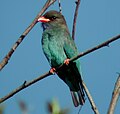Superregnum: Eukaryota
Regnum: Animalia
Subregnum: Eumetazoa
Cladus: Bilateria
Cladus: Nephrozoa
Superphylum: Deuterostomia
Phylum: Chordata
Cladus: Craniata
Subphylum: Vertebrata
Infraphylum: Gnathostomata
Superclassis: Tetrapoda
Cladus: Reptiliomorpha
Cladus: Amniota
Classis: Reptilia
Cladus: Eureptilia
Cladus: Romeriida
Subclassis: Diapsida
Cladus: Sauria
Infraclassis: Archosauromorpha
Cladus: Crurotarsi
Divisio: Archosauria
Subsectio: Ornithodira
Subtaxon: Dinosauromorpha
Cladus: Dinosauria
Ordo: Saurischia
Cladus: Theropoda
Cladus: Neotheropoda
Infraclassis: Aves
Cladus: Euavialae
Cladus: Avebrevicauda
Cladus: Pygostylia
Cladus: Ornithothoraces
Cladus: Euornithes
Cladus: Ornithuromorpha
Cladus: Ornithurae
Cladus: Carinatae
Parvclassis: Neornithes
Cohors: Neognathae
Ordo: Coraciiformes
Familia: Coraciidae
Genus: Eurystomus
Species: E. azureus – E. glaucurus – E. gularis – E. orientalis
Name
Eurystomus Vieillot, 1816
References
Analyse D'Une Nouvelle Ornithologie Élémentaire: 37.
Vernacular names
беларуская: Шыракароты
English: Dollarbirds
français: Rolle
lietuvių: Plačiaburniai
русский: Широкороты
Kiswahili: Jore
Eurystomus is a genus of roller, one of the two genera in that family of birds. The name means ‘broad mouth’, from the Greek eurus (εὐρύς, ‘broad, wide’) and stoma (στόμα, ‘mouth’).[1]
Eurystomus contains four broad-billed species, which breed in Africa, Asia and Australasia. Two species are restricted to Africa, one of which, the broad-billed roller, is migratory. The oriental dollarbird has a large distribution ranging from India to Japan and Australia and it too, is migratory over the northern and southern extremes of its range. The final species, the azure dollarbird, is endemic to the Moluccas in Indonesia. In general they are open country foragers, occurring in woodland, savanna and farmland. The azure dollarbird and the broad-billed roller are both associated with rainforests but nevertheless require open areas in which to forage.
The species of the genus Eurystomus vary from the other genus of rollers, Coracias, in having proportionally longer wings and shorter legs. These morphological differences are reflected in differences of foraging techniques. Coracias rollers forage from a fixed perch and take prey by swooping down onto it on the ground, while the faster and more agile Eurystomus rollers catch their prey on the wing. Unlike the species of the genus Coracias, they do not perform the "rolling" display which gives the family its common name.[2]
Taxonomy
The genus Eurystomus was introduced in 1816 by the French ornithologist Louis Jean Pierre Vieillot to accommodate the Oriental dollarbird.[3][4] The name is from Classical Greek eurustomos meaning "wide-mouthed".[5]
A molecular phylogenetic study by Ulf Johansson and collaborators published in 2018 found that the azure dollarbird (Eurystomus azureus) was nested in a clade containing subspecies of the Oriental dollarbird (Eurystomus orientalis).[6]
| Eurystomus |
|
|||||||||||||||||||||||||||||||||
Species
| Image | Scientific name | Common Name | Distribution |
|---|---|---|---|
 |
Eurystomus gularis | Blue-throated roller | western sub-Saharan Africa from Guinea to Cameroon, south to northern Angola, and west to south-eastern Uganda |
 Madagascar, crop.jpg" decoding="async" srcset="//upload.wikimedia.org/wikipedia/commons/thumb/8/86/Broad-billed_Roller%2C_Ankarafantsika%2C_Madagascar%2C_crop.jpg/180px-Broad-billed_Roller%2C_Ankarafantsika%2C_Madagascar%2C_crop.jpg 1.5x, //upload.wikimedia.org/wikipedia/commons/thumb/8/86/Broad-billed_Roller%2C_Ankarafantsika%2C_Madagascar%2C_crop.jpg/240px-Broad-billed_Roller%2C_Ankarafantsika%2C_Madagascar%2C_crop.jpg 2x" data-file-width="1764" data-file-height="1701" height="116" width="120" /> Madagascar, crop.jpg" decoding="async" srcset="//upload.wikimedia.org/wikipedia/commons/thumb/8/86/Broad-billed_Roller%2C_Ankarafantsika%2C_Madagascar%2C_crop.jpg/180px-Broad-billed_Roller%2C_Ankarafantsika%2C_Madagascar%2C_crop.jpg 1.5x, //upload.wikimedia.org/wikipedia/commons/thumb/8/86/Broad-billed_Roller%2C_Ankarafantsika%2C_Madagascar%2C_crop.jpg/240px-Broad-billed_Roller%2C_Ankarafantsika%2C_Madagascar%2C_crop.jpg 2x" data-file-width="1764" data-file-height="1701" height="116" width="120" /> |
Eurystomus glaucurus | Broad-billed roller | tropical Africa and Madagascar |
 |
Eurystomus orientalis | Oriental dollarbird | Australia to Japan and India. |
| Eurystomus azureus | Azure dollarbird | Maluku Islands in Indonesia |
References
William Somerville Orr (1855). Orr's circle of the sciences: a series of treatises on the principles of science, with their application to practical pursuits. W.S. Orr & Company. p. 517.
Fry, C (2001), "Family Coraciidae (Rollers)", in del Hoyo, Josep; Elliott, Andrew; Sargatal, Jordi (eds.), Handbook of the Birds of the World. Volume 6, Mousebirds to Hornbills, Barcelona: Lynx Edicions, pp. 342–369, ISBN 978-84-87334-30-6
Vieillot, Louis Jean Pierre (1816). Analyse d'une Nouvelle Ornithologie Élémentaire (in French). Paris: Deterville/self. p. 37.
Peters, James Lee, ed. (1945). Check-List of Birds of the World. Volume 5. Cambridge, Massachusetts: Harvard University Press. p. 244.
Jobling, James A. (2010). The Helm Dictionary of Scientific Bird Names. London: Christopher Helm. p. 154. ISBN 978-1-4081-2501-4.
Johansson, U.S.; Irestedt, M.; Qu, Y.; Ericson, P. G. P. (2018). "Phylogenetic relationships of rollers (Coraciidae) based on complete mitochondrial genomes and fifteen nuclear genes". Molecular Phylogenetics and Evolution. 126: 17–22. doi:10.1016/j.ympev.2018.03.030.
Kingfishers, Bee-eaters and Rollers by Fry, Fry and Harris, ISBN 0-7136-8028-8
Retrieved from "http://en.wikipedia.org/"
All text is available under the terms of the GNU Free Documentation License

